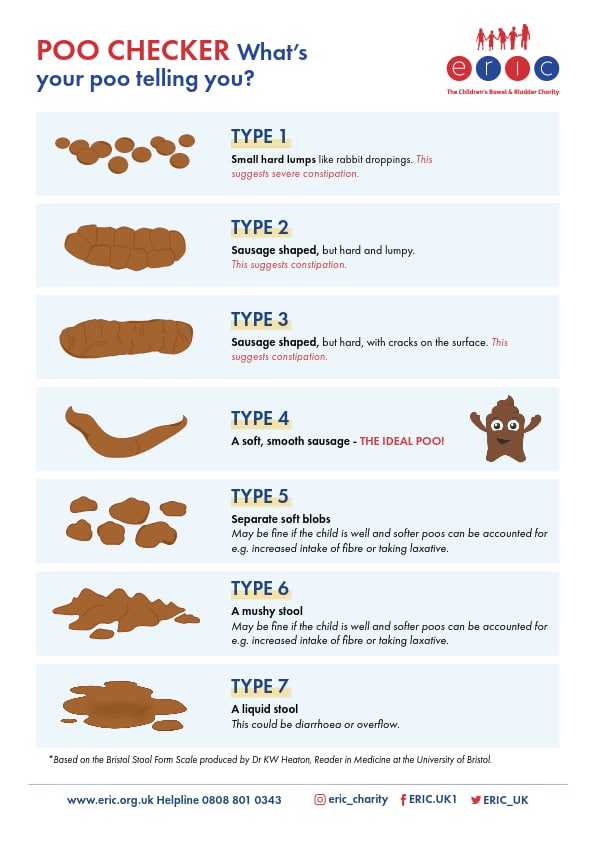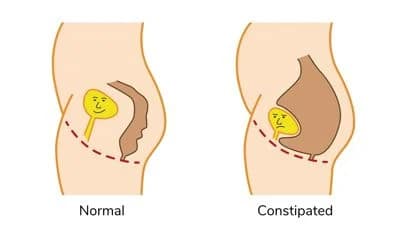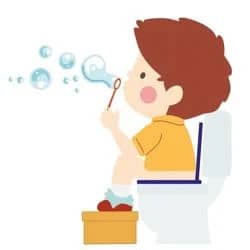Free helpline: 0808 801 0343 Mon to Thur, 10am - 2pm
Advice for children with constipation
How does the bowel work?
- The food we eat gets mashed around in the stomach and turns into a soupy mixture.
- This moves into the small bowel, where all the nutrients (the good stuff) are taken out to be used by the body to keep us healthy.
- As it travels along the large bowel, water is absorbed and the poo turns into a smooth sausage shape ready to be passed.
- The poo in the large bowel moves along every time the gut muscles squeeze.
- When the poo reaches the rectum, the rectum stretches and that sends a message to the brain saying we need a poo.
What can go wrong?
- If we don’t respond to this message, the poo just stays there.
- The gut muscles keep squeezing so more poo arrives, as poo builds up in the large bowel more water is absorbed, and the poo becomes harder and gets stuck.
- Messages are only sent to the brain when the rectum stretches. If it stays stretched, you won’t get a new message telling you need a poo.
- Very soon you have got a poo traffic jam, also known as constipation.
Constipation is very common in children, it affects 1 in 3 children, even babies. Don’t wait for it to get better by itself. TAKE ACTION!
What's your poo telling you?

How can you tell if a child is constipated?
- Children should pass soft poo every day, or at least every other day.
- Passing types 1 - 3 means poo is sitting in a traffic jam.
- Pooing fewer than 4 times a week also means poo is in a traffic jam.
- Pooing more than 3 times a day can be a sign that the bowel is full, and is leaking out a bit at a time.
- Soiling - it might be hard bits, soft stuff or even liquid bypassing the traffic jam, called overflow. The child won’t have any control over this.
- Big poos, or lots of poo all at once.
- Tummy ache or pain when they poo.
- Distended/swollen tummy.
- Really smelly poo/wind, or bad breath.
- They might not feel like eating, or even feel sick.
- The full bowel might press on the bladder and cause frequent small wees/urgency/day or night time wetting/Urinary tract infections.

HAVING JUST TWO OF THE ABOVE SYMPTOMS MEANS CONSTIPATION!
How to treat constipation:
- Keep a Poo Diary for 2 weeks: what it looks like, how much, where it goes.
- See your GP: Take the poo diary and tell them all your child’s symptoms.
- The GP should examine your child and ask questions to find out if the constipation could be caused by an underlying condition.
- The GP should prescribe a macrogol laxative like Movicol, Laxido or CosmoCol which softens poo and helps move it along (as per NICE Guidelines).
Taking laxatives:
- The macrogol must be mixed with the right amount of water first, but then other food/drink can be added – read: How to use macrogol laxatives.
- Most children start with disimpaction – this means taking lots of medicine to clear out the backlog of poo – read: A Parent’s Guide to Disimpaction.
- When the bowel is clear they will need to keep taking a smaller dose each day to keep their poo soft and moving along.
- Your child might need to stay on laxatives for a long time, but don’t worry, laxatives won’t hurt them. However, in the long term, undertreating constipation will.
Getting the poo in the loo

- Get there at the right time - 20 to 30 minutes after meals and before bed.
- Sit in the right way: feet flat and firmly supported on a box or stool, knees higher than hips. Secure sitting position - they might need a children’s toilet seat.
- RELAX to let the poo out. So keep toys, games and books beside the toilet.
TRY TO MAKE EACH TOILET SIT ‘ACTIVE’ BY ALTERNATING
PLAY ACTIVITIES AND EXERCISES:
- Massaging the tummy in clockwise circles, and rocking forwards and backwards on the toilet can really help.
- Laugh/cough/blow to help push down with the tummy muscles.
- Make it a fun time! Look at ERIC’s Toileting Reward Chart for more ideas to motivate your child. 10 to 15 minutes should be long enough for a toilet sit.
Promoting a healthy bowel:
- Encourage your child to drink 6 - 8 water based drinks every day.
- Include fruit and vegetables in their diet.
- Exercise and move around!
Last Reviewed: February 2024
Next Review: February 2027
On this page...
Upcoming events
Share this page
